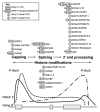Pause, play, repeat: CDKs push RNAP II's buttons
- PMID: 23756342
- PMCID: PMC3977912
- DOI: 10.4161/trns.25146
Pause, play, repeat: CDKs push RNAP II's buttons
Abstract
Cyclin-dependent kinases (CDKs) play a central role in governing eukaryotic cell division. It is becoming clear that the transcription cycle of RNA polymerase II (RNAP II) is also regulated by CDKs; in metazoans, the cell cycle and transcriptional CDK networks even share an upstream activating kinase, which is itself a CDK. From recent chemical-genetic analyses we know that CDKs and their substrates control events both early in transcription (the transition from initiation to elongation) and late (3' end formation and transcription termination). Moreover, mutual dependence on CDK activity might couple the "beginning" and "end" of the cycle, to ensure the fidelity of mRNA maturation and the efficient recycling of RNAP II from sites of termination to the transcription start site (TSS). As is the case for CDKs involved in cell cycle regulation, different transcriptional CDKs act in defined sequence on multiple substrates. These phosphorylations are likely to influence gene expression by several mechanisms, including direct, allosteric effects on the transcription machinery, co-transcriptional recruitment of proteins needed for mRNA-capping, splicing and 3' end maturation, dependent on multisite phosphorylation of the RNAP II C-terminal domain (CTD) and, perhaps, direct regulation of RNA-processing or histone-modifying machinery. Here we review these recent advances, and preview the emerging challenges for transcription-cycle research.
Keywords: RNA polymerase II; RNA-processing; TFIIH; chemical genetics; cyclin-dependent kinase; positive transcription elongation factor b; promoter-proximal pausing; termination; transcription.
Figures


References
-
- Morgan D. The Cell Cycle: Principles of Control. Oxford University Press, 2006.
Publication types
MeSH terms
Substances
Grants and funding
LinkOut - more resources
Full Text Sources
Other Literature Sources
Research Materials
